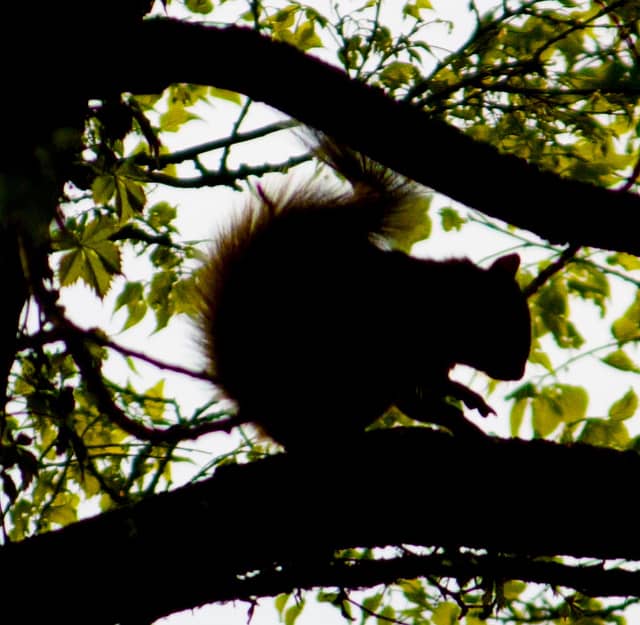Squirrel Bot Flies: Fact Versus Fiction
Alabama DCNR 10.30.12

Hunters sometimes harvest squirrels early in the hunting season that appear to be covered in tumors or lumps. These tumors are most likely the embedded larvae of squirrel bot flies (Cuterebra species), which are natural parasites of grey and fox squirrels and rabbits in the South. The old folks used to call these “wolves” and said you had to throw the infested squirrel(s) away and that you had to wait until after the first frost to hunt squirrels. These are just two of many myths about wolves that have been passed down through the generations. Many hunters don’t know much about this parasitic condition and may be fearful that these unsightly burrows can be harmful to the meat or even to themselves. This article should help clear up some of the myths surrounding bot flies.
Squirrel bot flies are worms. Fiction.
Squirrel bot flies are not parasitic worms, but instead, fly larvae of a certain species that use rabbits and rodents to complete their life cycle. The adult flies mate and lay their eggs in runways in branches and leaves, and the hatching larvae then wait for a host to pass by. After the tiny larvae are picked up by the host, they crawl around in the fur looking for a place to enter the skin (often natural body orifices). Once the larvae establish a burrow or feeding site in the squirrel, they will begin to grow and develop inside, creating “warbles” that outwardly appear as lumps or tumors. Over the next few weeks, the larvae will continue to grow and eventually emerge from the burrow and fall to the ground to finish the last stage of development. This stage is known as the pupal stage. These pupae may hibernate a few inches underground until the next spring when they will emerge as adult flies to start the cycle over again. The adult squirrel bot fly looks like a bumble bee and only lives about two weeks.
Squirrels with bots (wolves) must be thrown away because the meat is spoiled. Fiction.
Bot fly larvae only reside right under the skin and not deep in the muscle tissue. Although the infestation may appear unsightly and look harmful, these burrows are not infectious and cannot be transmitted from pet-to-pet or human-to-human. Although this is a case of true parasitism, a healthy squirrel can apparently tolerate the larvae quite well, with no obvious adverse effects.
Bot fly larvae can be found in other hosts such as rabbits, chipmunks, cats and dogs. Fact.
Although squirrels are some of the most visible hosts, other animals such as dogs, cats, raccoons, rabbits and chipmunks may also be infested with bot flies.
Squirrel fly larvae can infest humans. Fact.
Although extremely rare, there have been reports of bot fly larvae infesting humans. One case involved a 3-year old boy living in Wayne County, Miss. Apparently, the boy was somehow infested while playing around outside near the woods (the family lived in a rural area). Note: these larvae are not transmitted from an infested squirrel-to-humans by touch because the larva is encapsulated in the squirrel. Only the tiny first instar larva is infective.
There are control measures to prevent these infestations in squirrels, such as waiting until after a frost to hunt. Fiction.
Because these larvae are natural parasites found in nature, there are no treatments or precautions available. Many people enjoy feeding squirrels around the house, but concerns about spreading larvae from one infested squirrel to other squirrels are unfounded because the larvae are developing inside the host and are not contagious. Further, waiting until after a frost has nothing to do with bot flies. They emerge from their hosts after feeding for a number of weeks no matter what the weather is like.
In closing, squirrel bots or “wolves” are not harmful to humans or any of the natural host animals they infest. If you kill a squirrel with bot fly larvae, it is safe to consume the squirrel with no concerns of contracting disease. Certainly, during cleaning, you can cut around that particular area of squirrel meat. However, if you do not feel comfortable consuming a bot fly-infested squirrel, then properly dispose of the animal. Although there are no treatments or preventive measures to prevent bot fly infestation in squirrels, there is no need to be concerned. These flies are generally not harmful, so relax and enjoy the hunt.
For more information contact Joe Goddard, Conservation Enforcement Officer, Alabama Division of Wildlife and Freshwater Fisheries,30571 Five Rivers Boulevard, Spanish Fort,AL36527; phone 251-626-5474.
The Alabama Department of Conservation and Natural Resources promotes wise stewardship, management and enjoyment of Alabama’s natural resources through five divisions: Marine Police, Marine Resources, State Lands, State Parks, and Wildlife and Freshwater Fisheries. To learn more about ADCNR visit www.outdooralabama.com.

